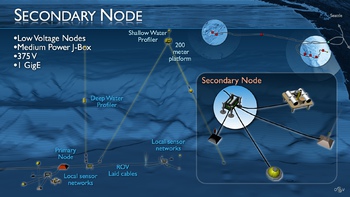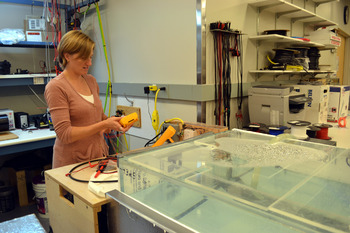- Visions18
- Visions17
- Visions16
- Visions15
- Visions14
-
Construction
- Node Installations Complete!
- Six on the Seafloor!
- New Segment 7
- Defining the SIA
- PN5A Successfully Deployed!
- PN 5A – Jointing Operations
- PN 5A Installation Continues
- On Site to Install PN5A
- Transit to Node 5A
- Port Call in Portland
- PN1D is Installed!
- Burial and Inspection Completed ...
- Humpbacks Visit
- Cable Burial Node PN1C
- Milestone: PN1C is Installed
- Photos of Final Inspection of P ...
- Another RSN Node is Born!
- Cable Burial Continues at Secon ...
- Second Node Installed!
- Splicing Node PN1B into Segment ...
- Recovering End of Segment 3
- Word for the Day: Persistence
- Major Milestone: First Node Ins ...
- Primary Node 1A Powered Up on D ...
- Recovering and Testing Cable Se ...
- OOI Primary Node Installation B ...
- Cable Installation Update
- Dolphins and Puffins and Molas, ...
- Day 51: Seabed Cable Lay Comple ...
- Dynamic Positioning
- Update on Cable Installation
- Completion of Segment 1 Burial
- Leaps and Bounds at the Shore S ...
- Segment 5 Installation Complete ...
- Laying Segment 5
- Bustling Shore Station
- At-Sea Installation Phases
- Installing the Land Cable
- TE SubCom Dependable Propulsion ...
- Divers at Work
- The Day After
- Second OOI Cable Landed
- Second Cable Landing Reschedule ...
- OOI Open House in Pacific City, ...
- The Cable has Landed!
- Last Grapnel Run Before Landing ...
- Preparing for the Cable Landing ...
- Seaplow 101
- Marine Mammal Observations
- Communicating with a Fishing Ve ...
- Cable Deployment Update
- Off Pacific City, Oregon
- Finished with First Segment
- Deploying Repeaters
- Start of First Cable Segment
- Leaving Astoria
- Meeting the Cable Ship in Astor ...
- Cable Laying Vessel Underway
- Photos of OOI Cable Loading
- Northern conduit installed
- Northern Conduit drilling compl ...
- Bubble test for the Southern Co ...
- Drilling of the Northern Condui ...
- Update on Drilling
July 2013
May 2013
December 2012
October 2012
August 2012
July 2012
April 2012
March 2012
January 2012
October 2011
September 2011
August 2011
July 2011
June 2011
March 2011
February 2011
October 2010
June 2010
May 2010
April 2010
- Visions13
- Visions12
- Visions11
- Enlighten
Related Blogs
Related Images and Videos : View All
In September 2012, the RSN Junction Box engineering team* at the UW Applied Physics Laboratory achieved an important milestone: they conducted interface testing after connecting a prototype of a low-power junction box to three standard oceanographic instruments planned for deployment on the RSN system.
The low-power junction boxes are one of three types of secondary nodes that serve as a bridge between the RSN instruments and the Primary Infrastructure. The primary nodes provide 10Gb/s interfaces and 8KV power from the shore station. The Secondary Nodes are comprised of low- and medium-power junction boxes and low-voltage nodes, and these nodes convert the 1 Gb/s bandwidth and 375dc voltage interfaces from the Primary Nodes to the native interfaces needed by the scientific instruments. Each instrument has its own unique interface that handles power and communications with the junction box. Each junction box provides up to eight instrument ports that can be configured for 12, 24 or 48V and 10/100BASE-T, RS232 or RS485 data links. Nodes can be daisy-chained, thereby creating extensive expansion capabilities.
The three instruments connected during the testing were: a Vertical Acoustic Doppler Current Profiler (VADCP), a Conductivity-Temperature-Depth (CTD) instrument, and a pressure sensor. The goal was early identification, before full production begins, of any communications or power interface issues between the junction box and the scientific instruments.
Mike Harrington, the APL senior engineer leading work on the RSN secondary nodes, explained that the three instruments in this test were all first articles--the first unit received from a vendor--and that each had already been accepted after passing tests in the saltwater tank in the Ben Hall Laboratory.
One of the important discoveries made during testing was that the VADCP had a larger-than-expected inrush current when it was turned on, higher than the electronics could accommodate. A solution was found to reduce the inrush current yet allow the VADCP to start up up properly. The CTD and pressure sensor each performed as expected and ran continuously for over two weeks as part of the testing.
Next step is for the junction box to go through formal First Article testing. In spring 2013, it will be integrated on its deployment frame with all attached instruments and will go through final integration testing in preparation for deployment in summer 2013.
*RSN Junction Box Engineering Team Members
Mike Harrington - Senior Engineer
James Tilley - Electrical Engineer Board Design
Jesse Dosher - Electrical Engineering Control Systems
Geoff Cram - Mechanical Engineering Lead
Patrick Waite - Mechanical Engineering Design
Dana Manalang - System Engineer - Instrument Integration Testing




